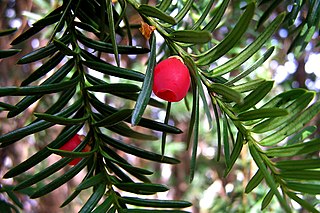
Taxaceae, commonly called the yew family, is a coniferous family which includes six extant and two extinct genera, and about 30 species of plants, or in older interpretations three genera and 7 to 12 species.

Torreya State Park is a 13,735 acre (56 km2) Florida State Park, United States National Natural Landmark and historic site thirteen miles (19 km) north of Bristol. It is located north of S.R 12 on the Apalachicola River, in northwestern Florida, at 2576 N.W. Torreya Park Road.

Picea breweriana, known as Brewer spruce, Brewer's weeping spruce, or weeping spruce, is a species of spruce native to western North America, where it is one of the rarest on the continent. The specific epithet breweriana is in honor of the American botanist William Henry Brewer.

Torreya nucifera is a slow-growing, coniferous tree native to southern Japan and to South Korea's Jeju Island. It is also called kaya (榧)Japanese torreya or Japanese nutmeg-yew.

Torreya taxifolia, commonly known as Florida torreya or stinking-cedar, but also sometimes as Florida nutmeg or gopher wood, is an endangered subcanopy tree of the yew family, Taxaceae. It is native to only a small glacial refugium in the southeastern United States, at the state border region of northern Florida and southwestern Georgia.
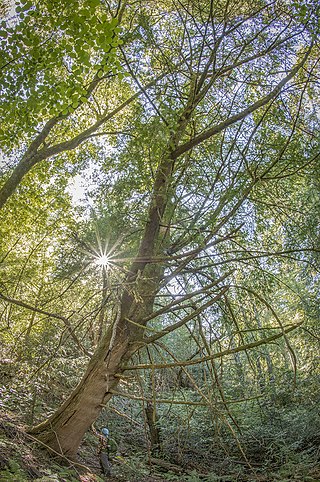
Torreya californica is a species of conifer endemic to California, occurring in the Pacific Coast Ranges and the foothills of the Sierra Nevada. It is commonly known as California torreya or California nutmeg tree. It is one of only two species of genus Torreya that are native to North America. A slow-growing subcanopy tree, it is listed as "vulnerable" in the IUCN Red List.

Cupressus funebris, the Chinese weeping cypress, is a species of cypress native to southwestern and central China. It may also occur naturally in Vietnam.

Cupressus torulosa, commonly known as the Himalayan cypress or Bhutan cypress, is a species of cypress tree native to the mountainous northern regions of the Indian subcontinent, in the western Himalayas.
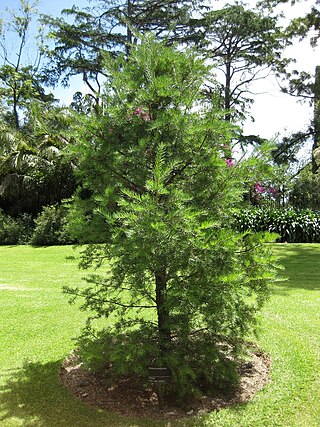
Keteleeria evelyniana is a species of conifer native to southern China, Laos and Vietnam. It can grow to a height of 40 metres (130 ft).

Taxus floridana, the Florida yew, is a species of yew, endemic to a small area of under 10 km² on the eastern side of the Apalachicola River in mesophytic forests of northern Florida at altitudes of 15–40 m. It is listed as critically endangered. It is protected in reserves at the Torreya State Park and at the Nature Conservancy's Apalachicola Bluffs and Ravines Preserve, and has legal protection under the United States and Florida Endangered Species laws.

Abies densa, the Bhutan fir, is a conifer species in the family Pinaceae. It is sometimes included in the East Himalayan fir as a variety.
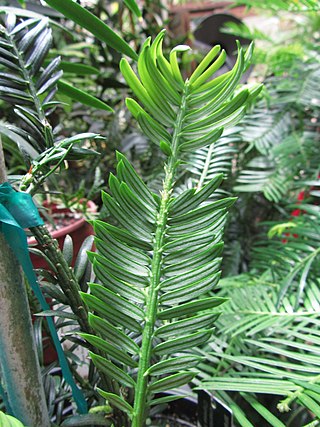
Amentotaxus argotaenia, the catkin yew, is a species of conifer in the family Taxaceae. It is a shrub or a small tree up to 7 metres (23 ft) tall.
Juniperus komarovii is a species of conifer in the family Cupressaceae. It is found only in China.
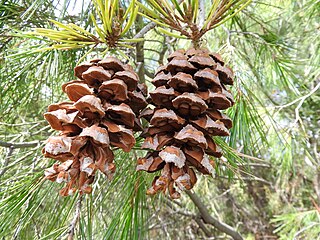
Pinus pinceana, with the common names weeping pinyon and Pince's pinyon pine, is a species of conifer in the family Pinaceae.

Pinus wangii, commonly known as the Guangdong white pine, is a species of conifer in the family Pinaceae.

Torreya grandis (Chinese: 香榧 is a species of conifer in either the family Taxaceae, or Cephalotaxaceae. Originated in the Jurassic period, about 170 million years ago, it is known as a "living fossil". 榧/fěi in 香榧/xiāngfěi is the genus name, and 香/xiāng" means fragrant. T. grandis is a large tree that can attain height of 25 metres, and possibly as high as 39 metres. T. grandis is endemic to eastern and south-eastern China; it is found in the coastal provinces Fujian, Zhejiang, and Jiangsu, as well as in Anhui, Guizhou, Hunan, and Jiangxi inland. Its natural habitat are mountains and open valleys, often by streams, between 200 and 1,400 metres ASL. One common name is Chinese nutmeg yew, which refers to its edible seeds that superficially resemble nutmeg and its yew-like foliage.T. grandis is a precious tree species with multiple values. According to the survey data, its economic life is more than a thousand years.

Paphiopedilum fowliei is a species of plant in the family Orchidaceae. It is endemic to Palawan in the Philippines. Its natural habitat is subtropical or tropical moist lowland forests. It is threatened by habitat loss.
Torreya fargesii is a species of conifer in the family Taxaceae. It is a large tree that can be up to 20 metres (66 ft) tall. It is endemic to central and southern China; it is found in Hubei, Hunan, Jiangxi, Shaanxi, Sichuan, and Yunnan provinces, and possibly in Anhui. It occurs in coniferous, mixed, and broad-leaved forests at altitudes 1,000–3,400 metres (3,300–11,200 ft) ASL. The seeds can be pressed for oil. The wood is used in construction and furniture.
Xianju National Park is a national park in Xianju County, Zhejiang, China. It lies between the Kuocang Mountains and Dalei Mountain in southeastern Zhejiang province. It shrouded by the cloud and mist all the year around. It covers an area of 301-square-kilometre (116 sq mi).

The Torreya Guardians is a self-organized group of conservationists dedicated to facilitating the assisted migration of the Florida torreya by rewilding it further north than its native range in Florida and Georgia. Founded in the early 2000s, the group is often mentioned as an instigator of the assisted migration of forests in North America for conservation and climate adaptation purposes. It is an example of citizen-initiated citizen science.

















